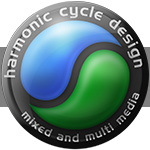Sound and Music
Studio Production Notes
|
Music
info about comparing -10dBv and +4dBu voltage levels
Introduction
This is an explanation of how to compare analog sound levels associated with +4dBu professional audio gear and -10dBV consumer or home entertainment audio equipment.
Professional analog audio electronics gear is often interconnected with cables. The input and output connections are often times described as designed for nominal +4dBu signal levels.
Consumer and Home Entertainment analog audio equipment is also often interconnected
with cables. The input and output connections are usually described as designed for nominal -10dBV signal levels.
Nominal signal level
The term nominal level describes the audio signal level which any particluar piece of electronics is designed to work with. The analog sound signal is AC voltage. The signal level can be measured on decibel meters that are calibrated to AC voltage levels. Decibel meters are used in an attempt to mimic the nature of sound as its energy level must increase or decrease exponetially for it to be percieved as doubling or halving in listening level.
When connecting professional and entertainment grade gear it is helpful to know how the nominal signal levels compare.
The AC voltage difference, in decibels, between +4dBu and -10dBV nominal signal levels is 11.79dB.
At first glance it may seem there is 14dB difference between +4dBu and -10dBV nominal signal levels but this is not the case. The 11.79dB difference between nominal +4dBu and -10dBV signal levels is evident when the different unit scale values are both referenced to AC voltage.
Unit scale values
The unit names "dBu", "dBv", "dBV", and "dBm" all have case sensitive spellings and have specific defintions regarding audio signal levels.
Professional analog gear is measured with dBu and dBv and dBm unit scales.
For example;
0dBu = 0.775 volts AC with an untermninated load.
0dBv = 0.775 volts AC into a 600ohm load.
0dBm = 1milliwatt at 0.775 volts AC into a 600ohm load.
Consumer and Home Entertainment analog gear is measured on a dBV unit scale. The opper case "V" indicates a different unit scale than the professional lower case "v" scale..
For example;
0dBV = 1 volt AC regardless of impedance load.
dBu, dBv, and dBm are considered somewhat interchangeable but, as mentioned above, The use of the units dBv and dBm suggests that the voltage is measured across a 600ohm load. There is very little 600 ohm gear made today, for a variety of reasons, most gear has a higher input impedance. The use of dBm and dBv has been deprecated and replaced by the dBu unit which is measured regardless of impedance.
Compare the volts
When +4dBu or -10dBV values are reconciled to the other's scale and the actual difference in voltage is compared you can see that there is a 11.79dB difference in voltage levels.
for example;
-10dBV = 0.316 volts AC
0.316 volts AC = -7.79dBu
-10dBV = -7.79dBu
+4dBu - (-7.79dBu) = 11.79dB difference
in other words, a -10dBv signal is 11.79dB lower than +4dBu
or for example;
+4dBu = 1.23 volts AC
1.23 volts AC = 1.79dBV
+4dBu = 1.79dBV
1.79dBV - (-10dBV) = 11.79dB difference
in other words, a +4dBu signal is 11.79dB greater than -10dBV
Why -10dBv?
The history of -10dBV is simply that old hi-fi gear was made to have lower output than professional gear as a cost saving measure.
When a pro item has a -10dBV input option the intention is to use the gain in the pro item rather than forcing the user to over drive their -10dBV gear into a input that expects a +4dBu signals. The idea is that you use the semi pro gear in it's sweet spot and the pro gear has enough gain to handle the rest.
An obvious question is to ask whether the *pro* gear is optimized for +4dBu or -10dBV. If the former, it will have adequate head room above and beyond +4dBu. Perhaps +26dBu max or 22dB headroom. If the *pro* gear is optimized for -10dBV then the +4dBu input may simply be padded to bring down the pro grade levels to the semi pro region. This would be done for cost cutting reasons and the headroom above +4dBu will generally be well below 22dB in those devices.
The only reason to use a -10dBV input is if your gear only works at -10dBV standard levels. In all cases connecting a -10dBv output to the input of +4dBU gear will increase the noise floor... if you do so and need to gain up to +4dBu nominal levels it is often cleaner to do it in the pro side of the connection.
If you connect a +4dBu output to a -10dBv input then you are sending a hot signal over the line and this will minimize the noise floor but it will also be hot and may overload the input. If you pad it down you may reduce the noise floor a bit but the -10dBV input will have to rebuild the gain if it goes further to another +4dBu device and the noise will likely return at the next stage.
Stuff that is good to know about +4dBu and -10dBV
If you plug a +4dBu output into a -10dBV input the signal is coming in 11.79dB hotter than the gear was designed for... turn something down.
If you plug a -10dBV output into a +4dBu input the signal is coming in 11.79dB quieter than the gear was designed for... turn something up.
|
|

